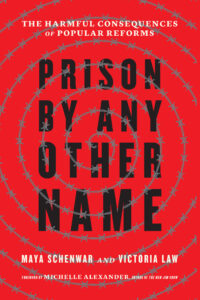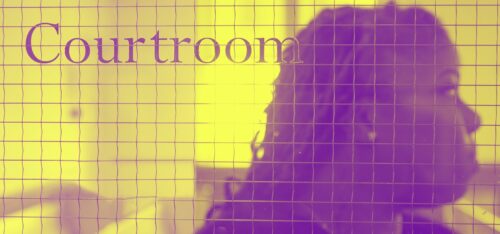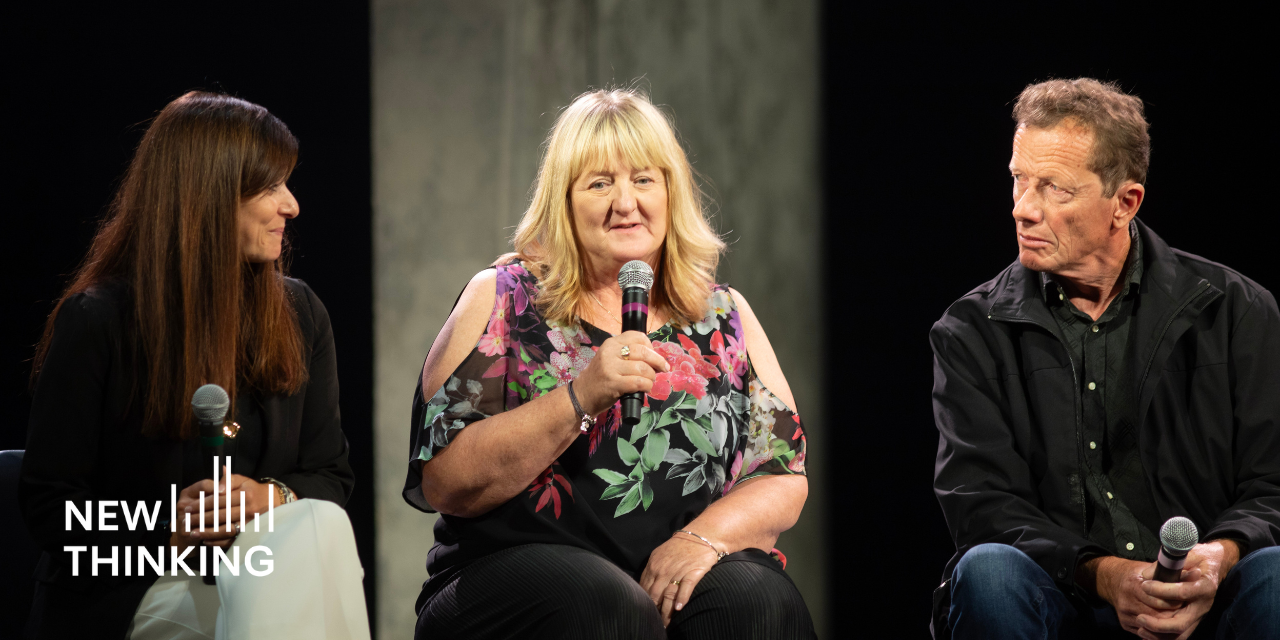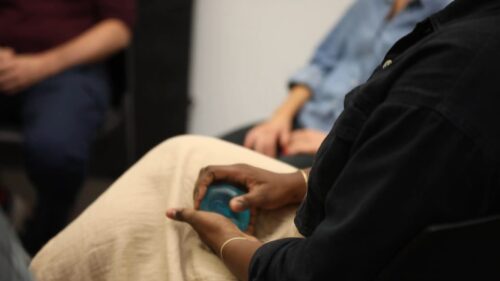
We’re challenging people to not just think of prison and policing as bars and steel, people with guns and badges, but to think about how these practices are embedded in our larger society.
It’s been said that the movement to reform prisons is as old as prisons themselves. But what is the ultimate goal of reform of a system like the criminal justice system—beyond simply “improvement,” which even its staunchest defenders would agree is urgent.
In their new book, Prison By Any Other Name, Maya Schenwar and Victoria Law argue that many of today’s most popular reforms—such as electronic monitoring or court-ordered treatment—are extending, rather than countering, the harmful effects of the criminal justice system.
Schenwar is the editor-in-chief of the nonprofit news organization, Truthout, and Law is a freelance journalist concentrating on the criminal justice system.
As Law explains to host Matt Watkins in this episode of New Thinking, their focus is on “institutions that are supposed to be helpful, but instead operate and replicate the logic of prisons.”
As against that logic, Schenwar and Law write in their book’s final chapter, “humans have always searched for solutions—for ways to support each other, defend each other, hold each other accountable, heal each other, and heal ourselves.” As they conclude of that quest, “we will still be doing it long after the prison is behind us.”
The following is a transcript of the podcast:
Victoria LAW: When we talk about the prison nation, then we’re also including many of the popular alternatives to incarceration in a physical jail or prison. And these alternatives include measures such as electronic monitoring and house arrest when somebody is confined to their home and is not allowed to leave without pre-authorization under threat of incarceration.
It also includes other alternatives, such as probation. The United States has 3.6 million people on probation. In addition to having the world’s largest number of people under mass incarceration, we also have a huge mass probation problem as well.
Looking at this through the lens of the prison nation also looks at institutions that are supposed to be helpful, but instead operate and replicate the logic of prisons such as mandated and lockdown drug treatment centers, and psychiatric confinement, as well as institutions such as sex offender registries. And other measures that are purported to keep people safe, but in reality just put more and more people and communities under surveillance and control, always with the threat of the loss of liberty and further punishment if they stray from what is deemed an acceptable norm.
Maya SCHENWAR: I think one of the things that we’re doing with our book is we’re challenging people to not just think of prison and policing as bars and steel, people with guns and badges. We’re asking people to think about how these practices, policies and concepts are embedded in our larger society. It’s to challenge us to not unintentionally support reforms that just reform the system in a slightly different image.
One of the things that we like to point out is that prison itself started as a reform, because it was reforming a system in which a lot of the punishments that were happening were corporal punishment and capital punishment, and confining people in cages basically was seen as a humane reform.
Now we’re seeing some similar measures in which, if you’re offered the choice between incarceration and electronic monitoring, certainly most people would choose to stay in their homes. But we’re saying we don’t think that the choice should be between two different kinds of cages.
Matt WATKINS: In some ways, it seems like you guys feel that the failure of reform is a sort of failure of imagination. We’re unable, or maybe we’re too invested in various ways, to look for solutions that can reach beyond the prison-industrial complex.
LAW: Yes, I think it’s a failure of imagination as to how do we actually keep people safe and hold people accountable for harmful behaviors.
We interviewed Ruth Wilson Gilmore, a carceral geographer and a professor at the CUNY Graduate Center. And she points out that actions and organizing that don’t seem connected to prisons—such as organizing for farm workers’ rights, organizing for pay equity, organizing around food justice—are all efforts that can lead to making prisons obsolete. Because if people have their needs met, they are a lot less likely to engage in the kinds of harmful behaviors that are criminalized.
Or maybe not even harmful, they’re less likely to engage in the kinds of behaviors that have been criminalized, such as crimes of poverty, and lands people behind bars, or lands people now in one of these supposedly kinder, gentler, more humane alternatives, such as probation, which ends up becoming a pipeline to prison nonetheless.
And instead, if we look at addressing people’s needs, and looking at it from a non-retributive approach, then we can say “what needs to happen, so that we don’t have these kinds of issues in our community, or what is happening here that this person is doing these types of behavior that either harm themselves or harm other people or are just illegal?”
WATKINS: And could one of you talk a little bit about this concept of “Somewhere Else” that you use quite a bit throughout the book?
SCHENWAR: This term Somewhere Else came up in one of the first interviews we did, which was with the abolitionist organizer Mariame Kaba. One of the things that Mariame said is that, “As long as we’re stuck in this prison nation mindset, people will always be looking to push people Somewhere Else.”
So if it’s not prison, maybe it’s a psychiatric institution. If it’s not a psychiatric institution, maybe it’s a treatment center. If it’s not a treatment center, maybe it’s locked in their home on electronic monitoring, but alternatives under the current system, they’re very often have to mean putting people somewhere.
To put it in more concrete terms, I think one of the things that always comes up when we speak about our work is people are really interested in, “Okay, what do you do with people, though?” Because prison has installed itself in people’s minds, and made them think that they need this system in order to be safe.
This assumption is false. It doesn’t bear out if you look at what police and prisons actually do. If prisons actually kept people safe, we would live in the safest society in the whole world! And actually, we’re a very violent country.
But this is the assumption that has been embedded in so many of our minds. And so, of course, the natural alternatives that would immediately appear would have to be putting people Somewhere Else that’s not prison, instead of challenging ourselves to address some of the root causes that result in people being funneled into this system.
WATKINS: If we turn to look at some of the reforms that you guys focus on in the book, you’ve mentioned electronic monitoring. That’s one, obviously, that a lot of jurisdictions seize upon, looking at it as being more cost-effective and allowing them to say, “Hey, we’re cutting down on our incarceration,” or traditional incarceration numbers. It’s seen as a kinder alternative to incarceration.
How does electronic monitoring and the problems with it fit into the larger argument you guys are making?
LAW: What we have to remember, with the exceptions of high-profile people like Harvey Weinstein and Jeffrey Epstein, who obviously had the best legal assistance that lots of money could buy, most people who are placed on electronic monitoring are placed on electronic monitoring, not because they pose some sort of danger, but often because they have been arrested and/or convicted of relatively low-level, minor criminalized actions that without electronic monitoring, they might not actually be under that kind of supervision at all.
Electronic monitoring has become a net widener for people to be placed under some type of surveillance and control without necessarily costing the state very much and forcing the state to put more money into incarcerating people in physical jails and prisons.
WATKINS: Often participants themselves are obliged to pay for the cost of the electronic monitoring, right?
LAW: Yes. It is not only a cost saver because you’re not paying for the housing, the water, the electricity, the correctional officers and their benefits and their overtime. But you’re also, then, in many jurisdictions, charging people for the cost of their electronic monitor, whether that goes to the jurisdiction, the county itself, and in many places, it goes directly to the private company that is administering the electronic monitoring.
The first person that we talk about in our book is a woman named Colette Payne, who lives in Chicago. Colette Payne is Black, she is a mother of three, and she was in and out of jail and in and out of prison because of a substance use addiction.
Then she was told that she could be on electronic monitoring instead of in the jail. And she thought, “I can be home with my children, with my family, participating in my community, perhaps seeking help for my drug addiction. Yes, let me do electronic monitoring instead.”
And what she found out is that electronic monitoring basically made her home into a prison. So yes, she could be with her children, she could go to her refrigerator at any hour of the night or morning, and take out whatever somebody had bought for it. But she wasn’t able to go to the store, she wasn’t able to participate in family functions that were outside of the house. And she wasn’t even able to seek drug treatment while she was on electronic monitoring because she needed to have pre-authorization from the sheriff’s department as to what she was allowed to do and when she was allowed to do that.
So, what ended up happening was she was just locked in her house, with the increasing urge to continue using drugs. And studies have found that strong relationships are among the most significant motivators to curb drug misuse. But being on electronic monitoring and house arrest did the opposite.
And finally she relapsed, she was arrested and then she was sent back to jail and then to prison. So what electronic monitoring did not do was it did not help her address the underlying causes. It did not help her meaningfully reconnect and re-cement her relationships with her family, and instead swapped out a jail cell or an overcrowded, chaotic jail dorm, for being locked in her house, and basically just extended this entire process of being caught in the criminal legal system.
And we have to remember that there are approximately 200,000 people on electronic monitoring. We don’t know the exact number because no agency keeps national statistics. And it’s grown even more during the early days of the coronavirus pandemic, when jails sought to release people from prison to decrease overcrowding and keep the virus from exploding behind bars.
And criminal legal system actors, such as judges and prosecutors and even jailers themselves, were not willing to just let people out on some sort of medical release, compassionate release, come back to court later the way that people might have in the old days and instead ordered them placed on electronic monitoring as a condition of their release from jail.
WATKINS: So, people like Colette Payne are in their communities, nominally—this is a community-based alternative to incarceration. But it seems like a lot of the intent of the book is to take issue with the way the criminal justice system, and some reformers, are using this word “community.”
SCHENWAR: I think “community” is so often used within the criminal legal system to just mean, not inside a jail cell. And that’s really a warping of the definition of community that I think a lot of us would use outside of that system, which is about relationships, which is about deepening connections to places and people and is a vital component of building a meaningful life.
What many of these community-based alternatives are doing is actually cementing separation and isolation for people.
WATKINS: You have a whole chapter with a critique of reforms around family law. I was struck as this independent review of racial bias in the New York State court system just came out, and it reported that, “Interviewees told us that the presence of armed officers in Family Court contributes to the impression that it is yet another institution that polices and controls people of color.”
That it struck me seems to speak to your general critique of the approach the state takes when it comes to what you call “policing parenthood.”
SCHENWAR: This is one of those systems that from the outside, or to the untrained eye, might look like solely a supportive system, something’s that even necessary for society to exist, called the child welfare system. But in many ways, the agents of that system are operating as police and imposing one of the most draconian punishments that can be imposed, which is separating families and ripping families apart.
It began as a system that primarily applied to white people—generally ished white children. But as it evolved and became a system that was surveilling and punishing Black people and other people of color, throughout actually the Civil Rights era into the ’70s, it was focusing increasingly on Black children.
And also, as the Indigenous schools, the residential schools, began to phase out toward the latter part of the twentieth century, it also focused more and more on Indigenous families. So now, the so-called child welfare system, as that changed as a system focusing more and more on Black and Indigenous families, it also became more punitive—more focused on family separation and on terminating parental rights—as opposed to supporting parents in being able to keep their children in the home or reunite with their children permanently.
So, I think that we have to look at this the same way that Vicky and I are encouraging people to look at prisons, as not just necessary systems that need a few adjustments, but as systems with a long history and grounding in racism, oppression, and injustice, and systems that are actively harming people.
So, if we want to be considering, well, “How can we actually support children and families?” We need to take several very large steps back and look at, not only the fact that these systems are not adequately supporting people—obviously, there’s still a high level of violence toward children in this country—but also consider that a lot of the violence toward children is actually coming in the form of these systems.
WATKINS: And then how about restorative justice? That’s a really buzzy concept these days amongst criminal justice reformers, and we hear a lot about restorative justice programs run in schools—the Center for Court Innovation has run some itself.
What are some of the ways you see that that concept is being misused, and packaged as more of an alternative, maybe than it really is, or could be? The concept itself, if implemented properly, is really a very radical one.
LAW: It definitely is. Going back to the podcast that you did on restorative justice and racial justice in schools, we see the ways in which restorative justice can actually address students’ underlying needs and bring people into conversation and dialogue. So, we’re not disputing that.
But what we have been seeing in certain jurisdictions, in certain schools is that schools sign on to the idea of restorative justice to say, “reduce in-school suspensions, reduce detentions and expulsions and school arrests,” but it’s a lip service in which the school police still get final say over what happens—they can decide whether or not restorative justice applies in any sort of case.
Oftentimes, teachers are not necessarily on board—they want to deal with problematic behaviors in the same ways that they have always done in the past. Again, this idea that you have to punish people. And it’s not always applied equally to people. So what we see in certain places is that it is applied and it works well, and people feel that they’re being heard. And even if the immediate behaviors are not totally changed, it’s a process.
And in other places, what we’re seeing is that restorative justice facilitators come in and they’re constantly undermined by the school administration and/or by the school police force, who don’t want to see their own authority undermined and want to have that authority to yell at students or to arrest students or threaten students with punishment.
And as people who have worked in restorative justice practices, who have worked in schools, know that that’s not actually how it works. The police are not supposed to be able to control what the process looks like. It is not supposed to be a top-down process in which one person has final say over everything else.
So we see that in some cases, restorative justice becomes a buzzword that schools adapt so that they can say we have a restorative justice program, or we have fewer arrests, or we have fewer suspensions, fewer expulsions, but they’re not willing to actually engage in the practice of changing the culture of that school, from the top down.
WATKINS: But are there maybe, I don’t want to be too reductive here, but criteria that you guys have been able to identify for distinguishing what we might call useful from false reforms?
SCHENWAR: One thing to keep in mind is reform really just means change. I think that one of the things that we always want to look out for as abolitionists is that we never want to be building up structures that we will need to tear down later. And so, we don’t want to be building nicer looking cages. We don’t want to be transforming jails into psychiatric jails or mental health jails or treatment jails.
We don’t want to be expanding jails to include places for babies to live so that mothers can stay with babies. Instead, we want the kinds of reforms that shrink those populations and free those people who are incarcerated with their children and find ways to support them in the community in real ways.
And then I think another thing to keep in mind is, we’re really interested in changes that are growing and building possibilities outside of the criminal legal system, outside of state control and surveillance and confinement. And so, work that’s happening around that—ways to expand health care, and housing, and the arts, and youth programming, and all of those things. Those are positive and generative and life-affirming changes that we want to see in the world as well.
WATKINS: And so, then, I ask this question with some trepidation. But I’m wondering what you make of an organization that’s very much devoted to reform of the system like the Center for Court Innovation?
LAW: I think we can look at it as: what are the programs doing to address people’s needs? Again, going back to the podcast you did about restorative justice, sometimes it’s hard to quantify. You can’t quantify how many suspensions did not happen.
So, I think for some of the work that the Center for Court Innovation does, it does work as a form of harm reduction—most people would much rather go to a program than to jail or to prison, even for a short period of time. But at the same time, we need to be careful that this doesn’t then become the de facto solution.
Instead of saying, “Let us just send everybody who has been arrested for a misdemeanor to this kind of program or this kind of court.” We should also be asking, “How do we get rid of all of these laws that allow police to arrest people for these misdemeanors?”
But while these are on the books, what are the ways where we can mitigate the harm that is being done while police are still arresting people for misdemeanors and making them sit in jails which, even not during a pandemic, are detrimental to their ability to rebuild their lives.
Even after 24, 48, or 72 hours in jail, you lose your job, you lose your source of income, maybe the child welfare system comes and takes your children away, when there are all these things that you then have to rebuild.
So if you look at, say, a misdemeanor program as something that would mitigate that, then yes, but if you’re looking at that as, “that is where the buck stops,” and we continue to allow police to arrest people for misdemeanors because they know now there’s a program that will just accept them, then it falls short of the goal, if the goal is to make sure that everybody’s needs are met, and we are shrinking this gigantic system of, not only mass incarceration, but a prison nation that seeks to penalize, punish, and lock up people.
WATKINS: And then as people who think a lot about the relationship between reform and maybe a more wholesale transformation, I’m wondering what you think of the defund police movement that took shape—I was going to say spontaneously, but it’s obviously the result of a huge amount of prior organizing—but this movement that emerged really onto center stage after the murder of George Floyd and other African Americans at the hands of police.
But I wonder what your read is on how that call is progressing?
SCHENWAR: I think the call to defund is a really important one because some of the reforms that we have seen transpire again and again in the system of policing include reforms that require more funding, that have actually expanded the system.
Everywhere that this call for defunding the police is happening, there’s a simultaneous call to grow other resources, to redistribute in ways that will actually support human beings and communities. So, we’re actually starting to think about the types of priorities that will reduce harm, reduce violence, including systemic violence.
WATKINS: A lot of the criminal justice system, and certainly a lot of reforms of that system, are focused on individuals. It’s very comfortable to just focus on individual “failings.” Somebody has a problem with drugs, “Okay, let’s mandate you as an individual into treatment that you have to do, or you go to jail.”
There’s a lot less focus on the structural failings of a larger system that helps to produce these problems for people. Is it that focus on structure, where when we talk about building a genuinely different system, is that where the focus has to be, where that begins?
LAW: Yes. Angela Davis has pointed out repeatedly that prisons disappear not only people, but they disappear the social problems that cause people to engage in criminalized behaviors.
If you lock up people who are poor, people who are homeless, people who have substance use disorders, then you are not only disappearing them from the community, but you’re hiding the fact that we have these structural failures in place that allow so many people to be homeless.
When we look at the numbers of people who have mental health issues on the street, people often just say, “Well, it’s because there was a deinstitutionalization movement in the 1960s and 1970s, that resulted in so many people with mental health issues not having a place to be.”
And what we don’t look at is that during the 1980s under Reagan, there were $30 billion in cuts in housing assistance and other types of structural supports that would have allowed people to be able to be housed in housing that was accessible and affordable and safe.
But when you disappear, when you criminalize people for acts of survival, or simply existing in places where people might not want them to exist, such as in New York City. The police over the summer arrested a man who was unhoused and was taking up two seats on the subway.
It is not an act that harms anybody. There’s no reason to arrest this person and take him to jail—where he might get COVID, he might endure all sorts of other traumas—simply because we as a society have failed to build structures that provide housing for people.
But when you arrest him, and you disappear him, you then don’t have to grapple with the questions of why are there so many people who are unhoused that rely on the subway system as their primary means of shelter? And it’s the same thing when we look at the policing of poverty, and even acts involving violence.
Looking at the unknown numbers of domestic violence survivors who are incarcerated for either defending themselves against intimate partner violence, or who have been coerced into criminalized actions by their abusive partners, and we disappear them, rather than saying, “What is it in our society that trapped this person in an abusive relationship and did not allow this person to escape?”
And perhaps even more broadly, “What is it in our society that causes domestic violence to be so accepted, particularly in the gendered way that it is?”
So yes, I think we have a focus on individual failings in our criminal legal system that allows us to ignore structural failings. And one of the things that Maya and I really tried to lift up in our book is that we need to look at structures and we need to say what structures need to be in place for people to not only survive, but to thrive in our society.
WATKINS: In the last chapter, you really do, in some detail, lay out a vision for a different world—not with simply institutions replacing prisons on a one-to-one basis. And in doing that, you quote the abolitionist organizer, Mariame Kaba, who says, “We have what we need to solve our problems.”
SCHENWAR: Having what we need is about looking to each other when it comes to answers around safety, around how we’re actually going to build the communities that we want, as opposed to relying on police and other forms of state control to tell us how we solve our problems.
This is one of those things that I think often people get a little bit defensive when they’re first hearing about abolition, and they say, “Okay, but what’s the answer?” Like, “What do we do instead? Give me that one, monolithic answer that is going to replace the prison system with that other world.”
And I think that one of the things that we need to do is ask ourselves, “Okay, what can I build—in my community, in my life? What can I build that is actually pursuing forms of justice and community and healing that are not based around police and carceral control?”
I think some of this relates to personal choices: are we going to call the police? How are we going to handle problems in our building, on our block, in our communities, in our personal lives? What are we going to do? And I think all of us, even those of us who have identified as abolitionists for years, are still working through those questions.
But then there’s also a really empowering part of that, which is that we actually have the power in our own hands to create those transformations. And, of course, we’re going to make mistakes. We mention in the book, one of the groups we cite, is the Just Practice Collaborative, which focuses on transformative justice and community accountability in relation to sexual harm.
And it’s named Just Practice for a number of reasons. But one of them is because it’s about practice, it’s not about perfection. We’re not creating perfect structures, perfect systems, perfect experiments. That’s not a thing. And so instead, we’re just practicing, we’re trying things. We’re building connections and relationships in our communities and working to see what we can build.
WATKINS: Well, Maya, Victoria, I want to congratulate you guys on the book. And I want to thank you so much for making the time to be here today. I really appreciate it.
LAW: Thank you so much for having us.
SCHENWAR: Absolutely. Thank you.





